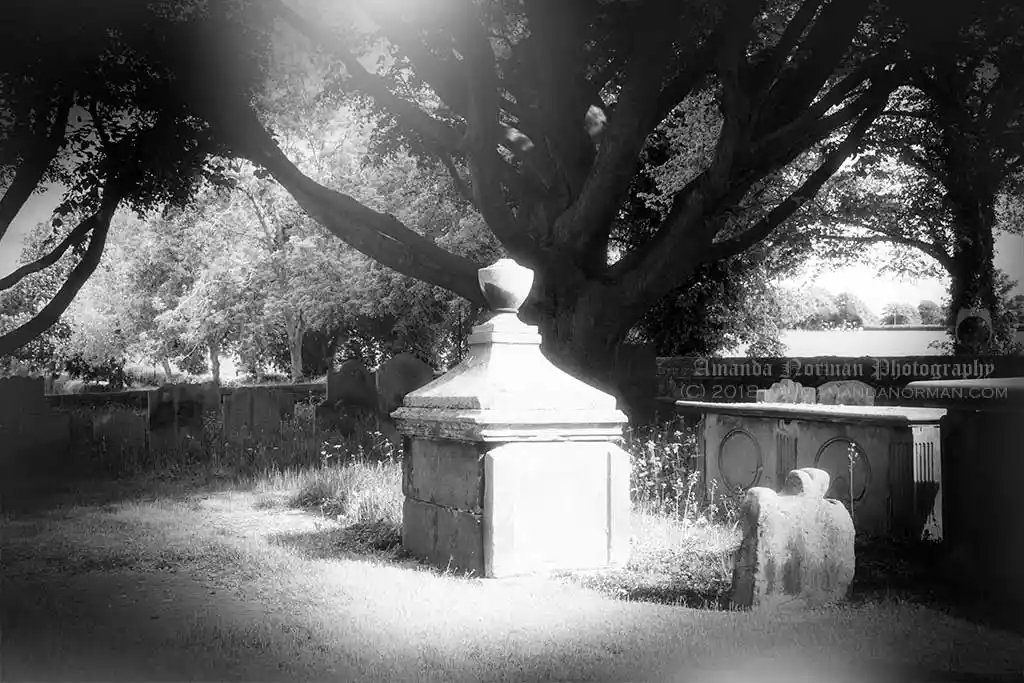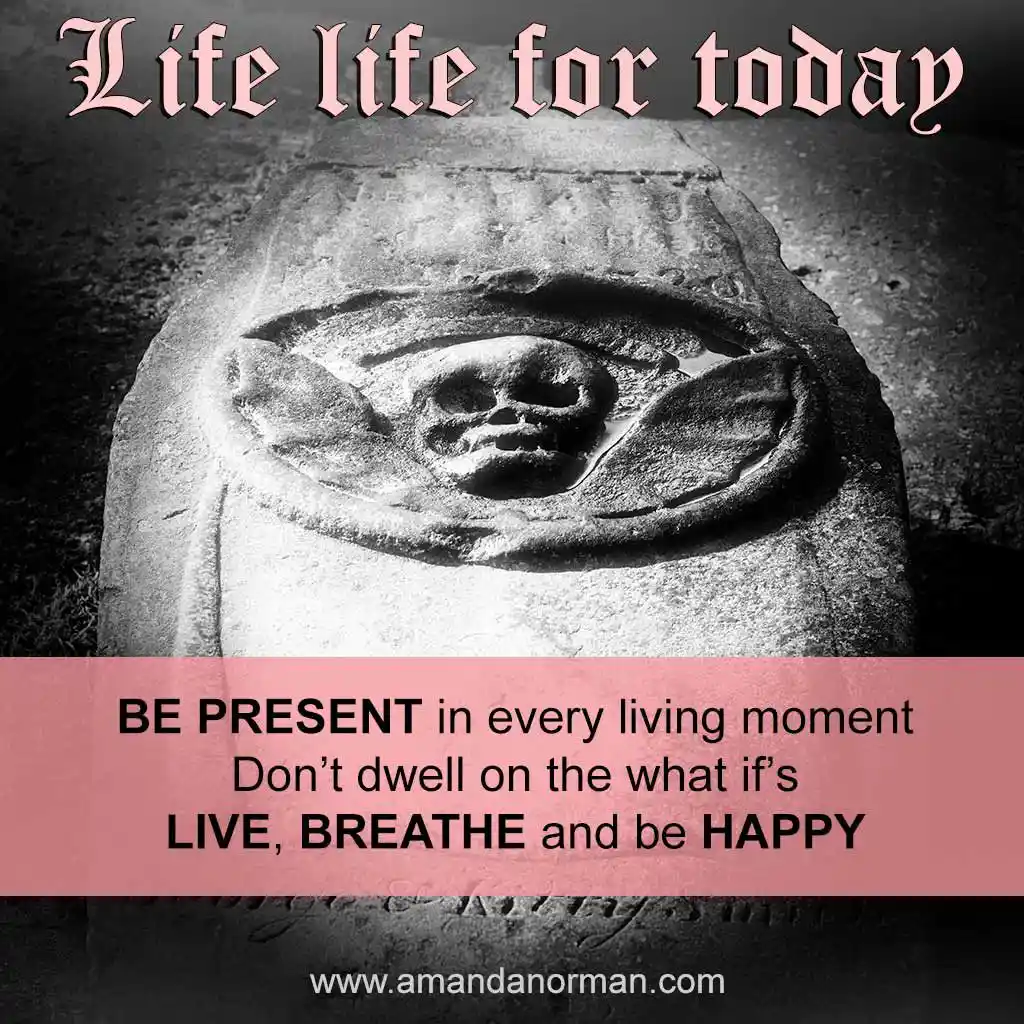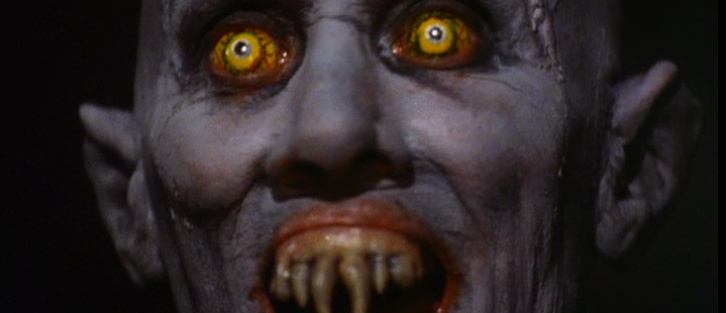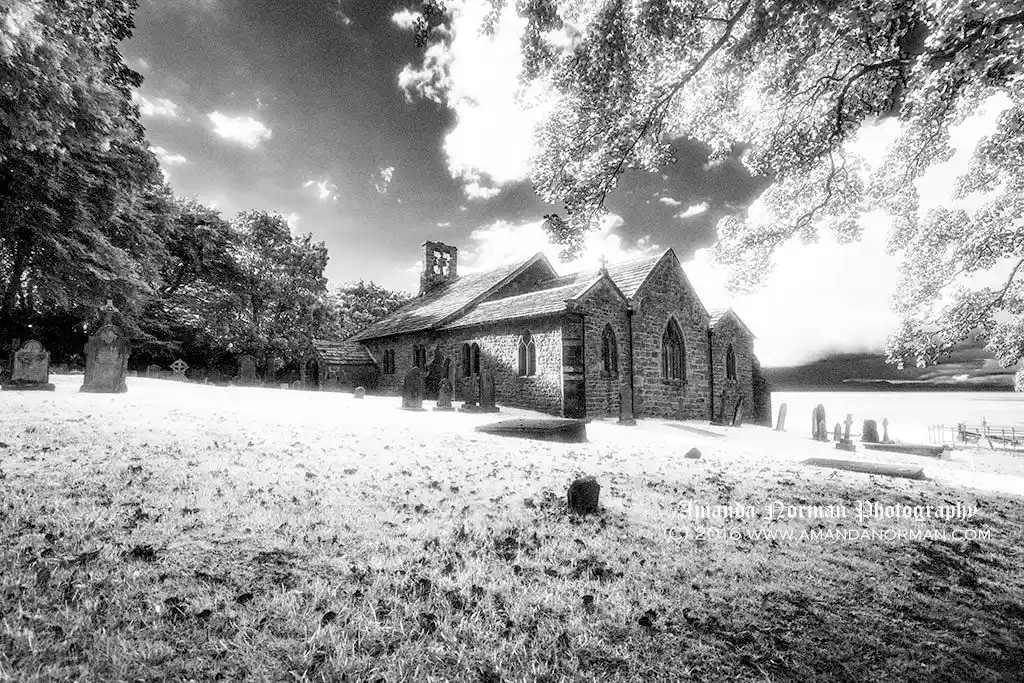My style of Gothic horror photography consists mainly of photographing graveyards, creepy locations and alternative portraits. Furthermore, the sense of peace and freedom I get from photographing these locations, is a form of self-therapy. Take for example the photograph below titled, The Beauty of Daresbury.
When visiting this graveyard and looking around, my senses are intrigued by what I see. Looking at this particular tomb, it clearly stands out and it looks withered from time, and the elements. Furthermore, the proximity of what I call, The Tree of Arms, maybe significant.
I begin pondering about the person buried here and if they chose this spot of beauty. Also, you can gain an idea of the wealth of a person, or their family and friends from their grave. This particular little graveyard is quiet and you can hear the birds chirping away. Again, I am using my sense of sight as I look at the contrast of light and dark. In addition, I’m also feeling the environment, the warmth and I’m thoroughly enjoying the sounds.
Mindfulness and Photography
This is my therapy as I am at one with nature and my surroundings. I am clearly in the present moment and loving it while practicing the technique of mindfulness. In addition, I am nurturing my soul with peace and calm. As a result, I’m raising my vibration that of course, makes me feel exceptionally well.
The remarkable aspect of this is that at the time, I didn’t realise exactly how good it was for me. I was finding my own space and freedom from stress, and anxiety.

Inspired by my love of Gothic horror
Owing to my love of Universal Horror Movies and Hammer Horror, I am highly influenced by what I want to achieve. I love their graveyard scenes with vampires and other creatures lurking in the mist. Lots of shadows add to the effect, creating a sense of dread or anticipation.
Originally, the film studios creating Gothic horror didn’t have CGI capabilities. The creators tapped into your senses using sound and vision with the ultimate aim of scaring you, with the unknown. I’m inspired by Gothic horror due to the possibility of ghosts, demons, vampires etc being real. In my opinion, a true art form was lost when CGI became a reality.
As you have no doubt seen by now, my Gothic horror photography emulates the old days. Undoubtedly, I find myself naturally drawn to creating emotive photography by playing in the shadows.
Shadow work is my self-therapy
Are you constantly fearing darkness or do you like the challenge of facing your fears?
More importantly, what is real and what is irrational fear?
Shadow work is a form of self-therapy. Previously, I was believing that I was only using the medium of Tarot cards to delve deep into my subconscious. Obviously, combining my love of Gothic horror and photography was an additional method.
I have recently been absent from my photography and this website. It is currently September 2023 and I’m revealing my hidden truths by revisiting my work. I’m drawn back here for a reason, and I am learning so much about myself. My shadows are well and truly alive with opportunities for personal growth.
Let us live life for today!
Since meeting Mark in 2013, he has taken me to some fascinating graveyards and cemeteries. I am wonderfully lucky to meet someone who shares similar interests.
Scotland and Ireland are two magnificent countries that I cannot wait to return to.

In Edinburgh, they have the most beautiful carved headstones full of mortality symbols. These consist of skull and crossbones and skeletons that just have to be seen. Moreover, Edinburgh is a perfect setting for Gothic horror photography. In Ireland, they have cadaver stones that depict a rotting corpse wrapped in a shroud. This is to remind the living, to live life for today as tomorrow it may end. So very apt since the onset of COVID!
Vampires are my number one love of Gothic horror
Vampires are my favourite element of Gothic horror and their presence inspires my work, especially when I find myself in an old graveyard. Of course, I am not seeing one however, I am fully inspired by the graveyard scenes of Hammer Horror. Rightly or wrongly, as a teenager, I remember the feeling of fear when they would rise from their tomb. Additionally, there were also feelings of excitement and suspense, especially when Christopher Lee rose to the occasion.
Perhaps Hammer Horror were inspired by the Gothic scenes featured in the Universal Horror movies. Who knows?
Nevertheless, old castles, decaying mansions and mist filled abandoned graveyards, bear feelings of intrigue, and wonder for me. Undoubtedly, there is no better setting for Gothic horror photography. I think it is the unknown element that attracts me as I find myself wondering if these creatures exist. Also, there IS something alluring and sexy about vampires.
In the beginning, I remember the feeling of shock when witnessing a vampire being beheaded. Yes, of course this was in a film!
Subsequently, I began falling for them and willing them to survive, especially The Count. I have such fond memories of Hammer Horror and the scenery. I will admit to wishing to be a vampire so that I can seduce anyone I want.

Gothic horror at its best!
At first, I did find it frightening to watch Hammer Horror films but this changed when I was introduced to Mr Barlow. Now, this type of vampire is truly hideous and terrifying. I’m sure that you can see what I mean? In addition, once seen, never forgotten! The original version of Salem’s Lot with David Soul is the one you should watch if you haven’t seen it. Again, made with no CGI! Gothic horror at its best!
You’ll enjoy Mr Barlow, and he will enjoy you!
Mr Straker played by James Mason in Salem’s Lot
Shadows of my mind
I wholeheartedly believe that there are things hidden in the shadows however, what is real and what is irrational?
What experiences have we faced and is our perception of what happened, true?
Distortion in NLP is one of the three major processes (including Deletion and Generalisation) on which the Meta Model is based. Distortion occurs when something is mistaken for that which it is not, when things are incorrectly included in our Internal Representations.
For instance, when you are looking for a certain piece of wire in a cupboard and you thought it was a grey colour, the wire you are looking for may not be there. But when you just looked, you found it (because it actually wasn’t grey). Or you see a snake moving in a desert and you run because you think snake! But it was a piece of discarded rope.
NLP World
Neuro Linguistic Programming (NLP) is a fascinating topic to explore however, I won’t bore you with it. Thankfully, as part of learning hypnotherapy, NLP was included and I have a great example of a distorted memory.
Death of the Massive Spider
As a small child, about the age of maybe six or seven, there lived a hideous spider in the trees of my garden. Me and my sisters commonly hid in these trees when playing hide and seek, but this suddenly stopped. This massive spider, which was the size of a dustbin lid, guarded the trees.
As a result, we were scared of walking anywhere near it. I remember crying because I was so scared of it. Then, one day, our step father had enough and went into the trees with a knife and killed it. Subsequently, we had our trees back and I never forgot about the death of the massive spider.
As an adult, I always struggle with this memory because logically, it cannot be true. Spiders that size don’t exist in England, but funnily enough, my sisters remember it like me. Heightened emotions were firmly planted in our memories causing a distortion of the facts. Again, I know that logically, it was not that big however, even now, I’m visualising how I thought I saw it as a child, and it was HUGE!
Changing the subject, do you believe in ghosts or spirits?
I myself have experienced situations that I don’t have an answer for and trust me, I am very sceptical.
For fun, I would leave my body
Again, about the age of five or six years old, I used to play a game were I would lie face down on my bed. Subsequently, I would enjoy leaving my body and floating through it, to lie on the floor. Furthermore, my experience was genuine as the dust particles would tickle the insides of my nostrils.
Clearly my mother wasn’t good at cleaning the carpet underneath the bed. I can’t remember how long I would stay on the floor for. Most importantly, if I heard someone coming up the stairs, in a flash I would be pulled back to my body, safe and sound.
Ghostly encounters
Furthermore, I remember being scared of going down the stairs. I had a feeling that an old man was about to peer over the banister and do something horrible. To get myself down the stairs, I would edge down slowly with my back against the wall, keeping watch. Once I was half way down, I would run the rest of the way.
What made me this scared?
Years later my daughter had an imaginary friend and I would often hear her playing with him. His name was ‘Kenny’. At the same time, I often saw a shadow darting past out of the corner of my eye. There was no explanation for seeing this shadow!
As an adult, I was once in a cemetery when I got a strong powerful feeling of being watched. I turned around and I can only describe it as a kind of heat shimmer moving past me, but I wasn’t terrified. Nervous yes!
Since my spiritual awakening, my psychic abilities are growing stronger. Before you say it, I do take this seriously and I practice protection.

Are you a descendant of Old Chattox, a Pendle Hill Witch?
I will always wonder if I am an ancestor of a Pendle Hill Witch named Old Chattox, (Anne Whittle). Indeed, my memory of my Grandad telling me this will never leave me. Unfortunately, she was sadly hung for witchcraft in Lancaster on the 20 August 1612.
Sadly, I don’t know how true this is, but I have tried to do my family tree. Going beyond the 18th century is difficult and I struggle due to a lack of information. Moreover, I do strongly believe that healing is in my ancestral roots.
Who inspires your Gothic horror photography?
Finally, oh the joy I felt when I discovered the late Sir Simon Marsden.
It began one night when I was flicking through the TV channels. Suddenly, I was well and truly in awe while watching a man walking through some creepy woods. Not only did the imagery capture my attention, it was his unmistakeable voice that eluded to something scary.
This TV program titled, The Twilight Hour introduced me to the late, Sir Simon Marsden who will forever remain the master photographer of this genre, for all eternity. http://www.simonmarsden.co.uk
